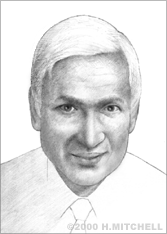Kumar Patel
There are many types of lasers, which vary in strength, efficiency and utility. Perhaps the most useful of them all is the carbon dioxide laser, invented by Kumar Patel in 1964.
C. Kumar N. Patel was born in Baramati, India in 1938. He received his bachelor’s degree in Telecommunications from Poona University at the age of 19 (1958) then came to the U.S. for graduate school. In short order, he earned an MS (1959) and PhD (1961) in Electrical Engineering from Stanford University. He was hired by AT&T Bell Labs in 1961, where he worked for over 30 years.
Upon joining Bell Labs in 1961, Patel began doing fundamental research in laser action in the pure rare gasses. This led him to discover laser action in carbon dioxide (1963). Patel added to this discovery his invention of efficient vibrational energy transfer between molecules, and the combination allowed him to invent the nitrogen carbon dioxide (CO2) laser --- the first gas laser to produce high power radiation continuously (1964).
Due to Patel’s unceasing efforts to find new uses for his device, the CO2 laser has more practical applications today than any other type of laser. In the hard sciences, it has improved high-resolution and saturation spectroscopy; contributed to laser-induced fusion and nonlinear optics; and is even used for the optical pumping that has made possible newer types of lasers (e.g., far-infrared and x-ray).
In industry, the CO2 laser is used in many forms of welding, cutting and drilling, including those at the micromechanical level, of materials ranging from diamonds to cigarette filters. In medicine, its primary use is in laser surgery, including the removal of tumors and various noncontact and noninvasive procedures. In the environment, it is used to analyze the chemical composition of the upper atmosphere, which aids in weather prediction, and specifically to detect pollutants existing there in ultra-low concentration (as little as one part per trillion). In communications, it forms the basis of a number of optoelectronic subsystems, some developed by Patel himself, such as infrared acoustic detection. Among military applications, its most striking contribution has been to the “Star Wars” system once promoted by Ronald Reagan and still being developed today. In fact, scientists find further uses for Patel’s CO2 laser all the time.
The CO2 laser was not the only type of laser that Patel invented. For example, Patel’s research in nonlinear optics led to the creation of the “spin-flip” Raman laser---the first tunable infrared laser (1969). In total, Patel has earned 36 U.S. patents for lasers and their applications.
In the early 1980s, Patel was appointed Director of AT&T Bell Labs’ Electronics Research Lab. While he never broke off his own research, Patel earned a reputation for energetic support of others’ work and for opening new areas of innovation. In 1993, the University of California at Los Angeles recruited Patel to be its Vice Chancellor for Research. At UCLA, where he’s Professor Emeritus Experimental Condensed Matter, Patel has overseen the improvement, modernization and expansion of the school’s many scientific research programs. In the national academic and scientific communities, Patel’s enthusiasm and vision have won him a number of leadership positions and honors. Kumar Patel won the National Medal of Science in 1996.


